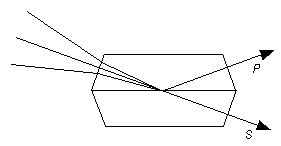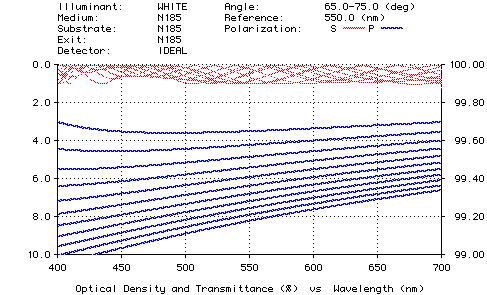New Thin Film Polarizing Beamsplitter
-
Li Li and J.A. Dobrowolski, "New developments in thin film polarizing beamsplitters", in Optical
Interference Coatings, Vol. 9, OSA Technical Digest Series, (Optical Society of America,
Washington DC, 1998), pp. 158-160.
given at the Optical Interference Coatings conference in June 1998, the authors discuss a new design for a high-performance polarizing beamsplitter based on frustrated total internal reflection. This polarizer has the following advantages: non-absorbing, broad band, wide-angle, and high extinction ratios (Ts/Tp and Rp/Rs). The diagram below illustrates the operation of this polarizer.

Although the authors do not give the exact details of the coating design, it is possible to use TFCalc to create such a polarizer. Here we design a polarizer for 400-700 nm to operate for the angles 65-75 degrees in the prism. This design requires a high-index glass prism. An index of 1.85 is used in this design. This means that the range of angles in air is ±9.28, which is considered wide-angle. We use the following 22 continuous optimization targets:
- S Transmittance > 99.9% for wavelengths 400-700 nm at angles 65,66,...,75
- P Optical Density > 3.0 for wavelengths 400-700 nm at angles 65,66,...,75

Here is the design, with the first layer closest to the substrate and
thickness given in nm:
H 11.16
L 48.87
H 35.94
L 68.58
H 39.50
L 79.77
H 46.20
L 96.61
H 49.71
L 102.74
H 50.49
L 102.74
H 49.71
L 96.61
H 46.20
L 79.77
H 39.50
L 68.58
H 35.94
L 48.87
H 11.16
Note, curiously, that optimization preserved the symmetry of the original design (i.e., layers 1 and 21, 2 and 20, 3 and 19, etc., have the same thickness).
The authors are commended for this ingenious polarizer, which is the subject of a patent application. However, it seems that this polarizer has two drawbacks: (1) the dimensions of the prisms may prevent its use in some applications and (2) the prisms seem to require a high-index glass, which presents other problems.
*Recently, a paper was published that gives much more detail about this polarizer. See
-
Li Li and J.A. Dobrowolski, "High-performance thin-film polarizing beam splitter operating
at angles greater than the critical angle", Applied Optics, Vol. 39, No. 16, pp. 2754-71.